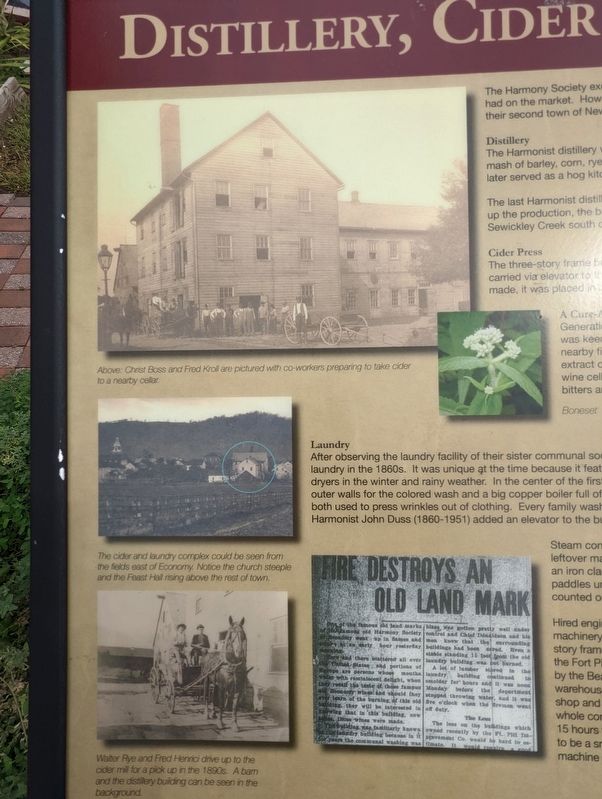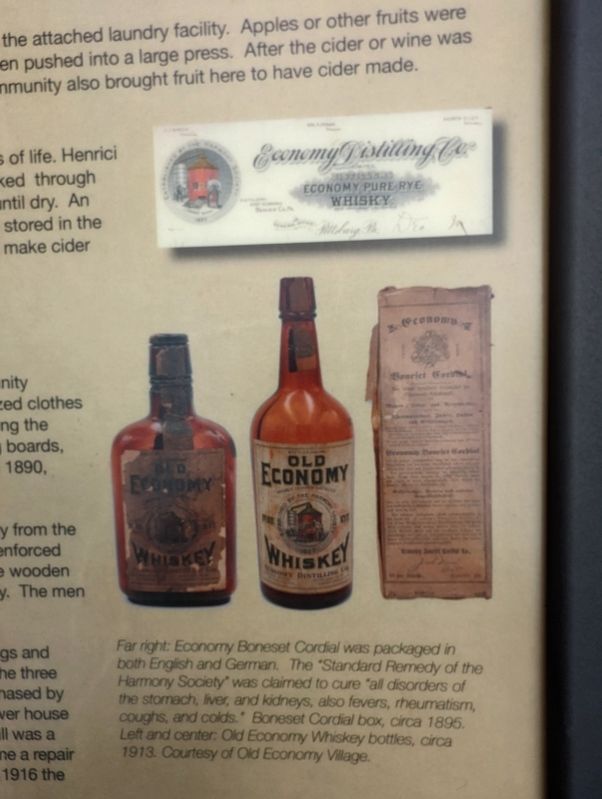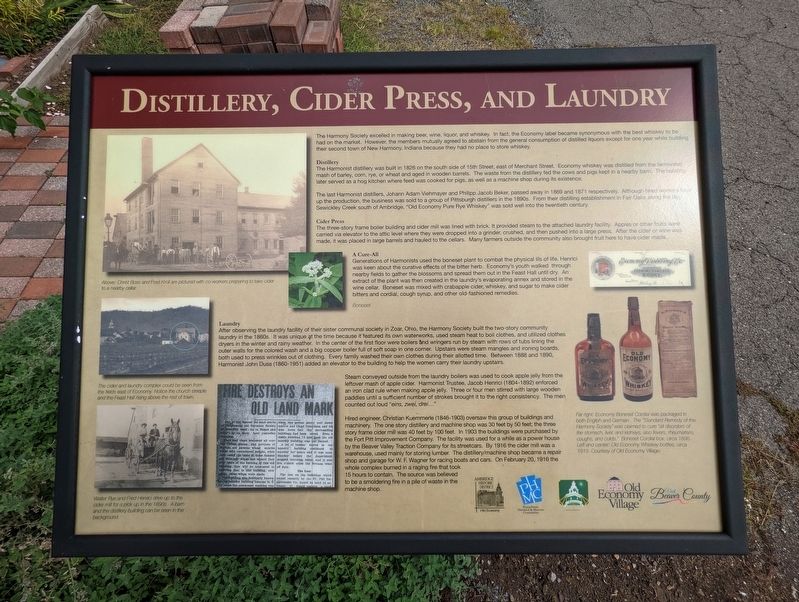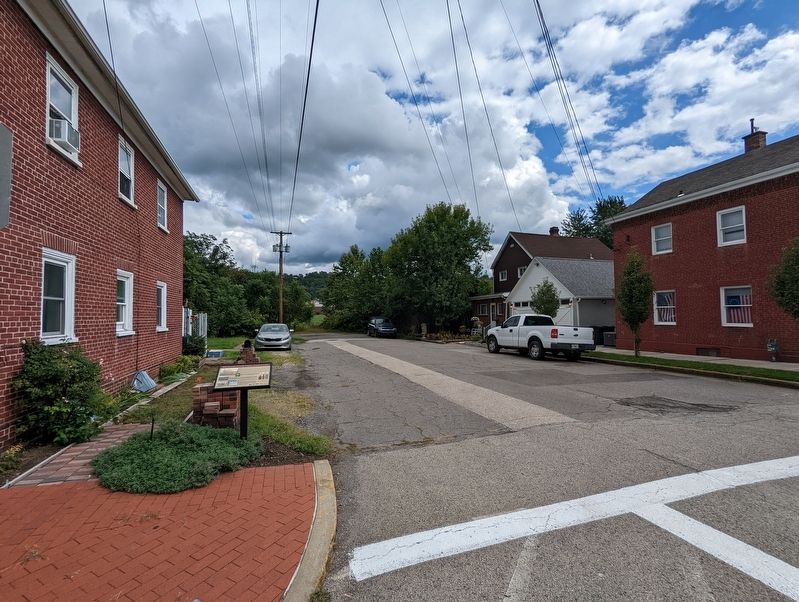Ambridge in Beaver County, Pennsylvania — The American Northeast (Mid-Atlantic)
Distillery, Cider Press, and Laundry
Inscription.
The Harmony Society excelled in making beer, wine, liquor, and whiskey. In fact, the Economy label became synonymous with the best whiskey to be had on the market. However the members mutually agreed to abstain from the general consumption of distilled liquors except for one year while building the second town of New Harmony, Indiana because they had no place to store whiskey.
Distillery
The Harmonist distillery was built in 1805 on the south side of 15th Street, east of Merchant Street. Economy whiskey was distilled from the fermented mash of barley, corn, rye, or wheat and aged in wooden barrels. The waste from the distillery fed the cows and pigs kept in a nearby barn. The building later served as a hog kitchen where feed was cooked for pigs as well as a machine shop during is existence.
The last Harmonist distillers, Johann Adam Viehmayer and Philipp Jacob Beker, passed away in 1869 and 1871 respectively. Although hired workers kept up the production, the business was sold to a group of Pittsburgh distillers in the 1890s. From their distilling establishment in Fair Oaks along the Big Sewickley Creek south of Ambridge, "Old Economy Pure Rye Whiskey" was sold well into the twentieth century.
Cider Press
The three-story frame boiler building and cider mill was lined with brick. It provided steam to the attached laundry facility. Apples or other fruits were carried via elevator the attic level where they were dropped into a grinder, crushed, and then pushed into a large press. After the cider or wine was made, it was placed in large barrels and hauled to the cellars. Many farmers outside the community also brought fruit here to have cider made.
A Cure-All
Generations of Harmonists used the boneset plant to combat the physical ills of life. Henrici was keen about the curative effects of the bitter herb. Economy's youth walked through nearby fields to gather the blossoms and spread them out in the Feast Hall until dry. An extract of the plant was then created in the laundry's evaporating annex and stored in the wine cellar. Boneset was mixed with crabapple cider, whiskey, and sugar to make cider bitters and cordial, cough syrup, and other old fashioned remedies.
Laundry
After observing the laundry facility of their sister communal society in Zoar, Ohio, the Harmony Society built the two-story community laundry in the 1860s. It was unique at the time because it featured its own waterworks, used steam heat to boil clothes, and utilized clothes dryers in the winter and rainy weather. In the center first floor were boilers and wringers run by steam with rows of tubs lining the outer walls for the colored and a big copper boiler

Photographed By Mike Wintermantel, September 13, 2022
2. Distillery, Cider Press, and Laundry Marker
Left Side Photos
Above: Christ Boss and Fred Kroll are pictured with co-workers preparing to take cider to a nearby cellar.
The cider and laundry complex could be seen from the fields east of Economy. Notice the church steeple and Feast Hall rising above the rest of town.
Walter Rye and Fred Henrici drive up to the cider mill for a pick up in the 1890s. A barn and distillery can be seen in the background.
Above: Christ Boss and Fred Kroll are pictured with co-workers preparing to take cider to a nearby cellar.
The cider and laundry complex could be seen from the fields east of Economy. Notice the church steeple and Feast Hall rising above the rest of town.
Walter Rye and Fred Henrici drive up to the cider mill for a pick up in the 1890s. A barn and distillery can be seen in the background.
Steam conveyed outside from the sundry boilers was used to cook apple jelly from the leftover mash of apple cider. Harmonist Trustee, Jacob Henrici (1804-1892) enforced an ironclad rule when making apple jelly. Three or four men stirred with large wooden paddles until a sufficient number of strokes brought it to the right consistency. The men counted out loud "eins, zwei drei..."
Hired engineer Christian Kuemmerle (1846-1903) oversaw this group of buildings and machinery. The one story distillery and machine shop was 30 feet by 50 feet; the three story frame cider mill was 40 feet by 100 feet. In 1903 the buildings were purchased by the Fort Pitt improvement Company. The facility was used for a while as a power house by the Beaver Valley Traction Company for its streetcars. By 1916 the cider mill was a warehouse, used mainly for storing lumber. The distillery/machine shop became a repair shop and garage for W.F. Wagner for racing boats and cars. On February 20, 1916 the whole complex burned in a raging fire that took 15 hours to contain.

Photographed By Mike Wintermantel, September 13, 2022
3. Distillery, Cider Press, and Laundry Marker
Right Side Photos
Far right: Economy Boneset Cordial was packaged in both English and German. The "Standard Remedy of the Harmony Society" was claimed to cure "all disorders of the stomach, liver, and kidneys, also fevers, rheumatism, coughs, and colds." Boneset Cordial box, circa 1895. Left and center: Old Economy Whiskey bottles, circa 1913. Courtesy of Old Economy Village.
Far right: Economy Boneset Cordial was packaged in both English and German. The "Standard Remedy of the Harmony Society" was claimed to cure "all disorders of the stomach, liver, and kidneys, also fevers, rheumatism, coughs, and colds." Boneset Cordial box, circa 1895. Left and center: Old Economy Whiskey bottles, circa 1913. Courtesy of Old Economy Village.
Erected by Ambridge Historic District, Pennsylvania Historical and Museum Commission, Ambridge Rotary Club, Old Economy Village.
Topics and series. This historical marker is listed in this topic list: Notable Buildings. In addition, it is included in the Communal and Utopian Societies, and the Rotary International series lists. A significant historical date for this entry is February 20, 1916.
Location. 40° 35.861′ N, 80° 13.827′ W. Marker is in Ambridge, Pennsylvania, in Beaver County. Marker is at the intersection of 15th Street and Merchant Street, on the right when traveling west on 15th Street. Touch for map. Marker is in this post office area: Ambridge PA 15003, United States of America. Touch for directions.
Other nearby markers. At least 8 other markers are within walking distance of this marker. Blacksmith and Wagonmaker Shops (here, next to this marker); Water Pump, Bank, Restaurant, Croatian Club (about 300 feet away, measured in a direct line); Economy Hotel (about 300 feet away); First Harmonist Church and Fire Department (about 400 feet away); Schools (about 500 feet away); Carriage House and Summer Kitchen (about 800 feet away); Harmonist Church / St. John's Lutheran Church (about 800 feet away); Harmony Society Church (about 800 feet away). Touch for a list and map of all markers in Ambridge.
Credits. This page was last revised on September 14, 2022. It was originally submitted on September 14, 2022, by Mike Wintermantel of Pittsburgh, Pennsylvania. This page has been viewed 186 times since then and 60 times this year. Photos: 1, 2, 3, 4. submitted on September 14, 2022, by Mike Wintermantel of Pittsburgh, Pennsylvania.

